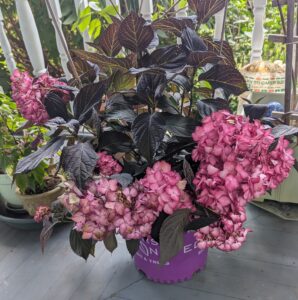 The last few years I have been quite taken by plants that feature black—or actually near-black—foliage. The rest of the gardening world seems to share that fascination, as the number of black-leafed perennials and shrubs has grown by leaps and bounds. Without too much effort you can now buy “Bishop’s Children” dahlias, the offspring of the famous ‘Bishop of Llandaf’, renowned for the contrast between its scarlet flowers and dark stems. It is also easy to lay hands on the ‘Midnight Reiter’ hardy geranium with purple blooms set against darkest purple foliage. If you are in a shrubby mood, you can invest in the beautiful ‘Black Lace’ ornamental elderberry or Sambucus nigra ‘Black Lace’, which bears ferny near-black leaves and delicate pink flowerheads.
The last few years I have been quite taken by plants that feature black—or actually near-black—foliage. The rest of the gardening world seems to share that fascination, as the number of black-leafed perennials and shrubs has grown by leaps and bounds. Without too much effort you can now buy “Bishop’s Children” dahlias, the offspring of the famous ‘Bishop of Llandaf’, renowned for the contrast between its scarlet flowers and dark stems. It is also easy to lay hands on the ‘Midnight Reiter’ hardy geranium with purple blooms set against darkest purple foliage. If you are in a shrubby mood, you can invest in the beautiful ‘Black Lace’ ornamental elderberry or Sambucus nigra ‘Black Lace’, which bears ferny near-black leaves and delicate pink flowerheads.
Why this fascination with black leaves? Most likely because they are new, different, and eye-catching, but also because they create an excellent contrast with green foliage and/or bright flowers. Commercial considerations have also played a role in the “back to black” garden surge. The product cycle in the horticultural business now moves almost as quickly as product cycles in other industries. The big companies that produce most new hybrid plants are always on the lookout for genera, species and varieties that check the modern boxes—easy to grow, disease resistant, amenable to container culture, and attractive in more than one season. Plants with similar attributes are grouped into collections and sold under trademarked names, making it easier for retailers and consumers to find and use them.
I was not specifically hunting for dark foliage last week, but I almost tripped over a great hydrangea that sports near-black leaves. It is Eclipse®, a traditional bigleaf hydrangea or Hydrangea macrophylla. The leaves caught my eye in the garden center, but the flowers were equally dramatic– cranberry red with touches of white. The plant was stunning, even though recent rains had made the flowerheads a little floppy.
A little research uncovered the fact that ‘Eclipse’ is a trademarked part of the First Editions® collection of plant introductions from a large garden breeder and merchandiser, the 118 year-old Bailey Nurseries, headquartered in St. Paul. Minnesota.
You may not know the Bailey name, but you may have seen shrubs from their Easy Elegance® line of roses, or purchased one of Bailey’s ‘Endless Summer’ reblooming hydrangeas. They are an old company that has navigated the shoals of time and marketplace changes by investing in plant breeding, aggressive branding and marketing, and building relationships with retailers and the public.
The dark-leafed ‘Eclipse’ has all the traditional bigleaf or mophead hydrangea qualities, including large, ball-shaped flowerheads and big, deciduous leaves. The flowerheads are cranberry with white touches when the plant is lodged in alkaline soil, and “amethyst”—bluish-purple—in more acidic soil. My new ‘Eclipse’ is still in its nursery container, so it currently sports the cranberry and white blooms. Next year’s in-ground flower array will most likely be blue.
Like ‘Endless Summer’, ‘Eclipse’ blooms on both “old” and “new” wood, a trait that is not shared by the older mophead varieties in my garden. I appreciate this feature, because I live in a climate where spring weather can be variable. If a late spring frost kills the flower buds on my existing hydrangeas, they are finished flowering for the year. .If the same thing happens to my new ‘Eclipse’, the current season’s stems will produce additional flowers later in summer.
According to the promotional copy, the leaves will stay dark, rather than reverting to green during the growing season, or later on, as the plant matures. Since the dark leaves are ‘Eclipse’s major selling point, this is important.
I will be watching carefully, as I am inherently suspicious of promotional encomiums.
I am sometimes conflicted about the big business of commercial horticulture, the standardization of plant breeding, and the loss of older non-hybrid varieties that have been superseded by heavily touted modern hybrids. Still, time only moves in one direction, and it would be silly to ignore new developments. I hope that ‘Eclipse’ will live up to the hype and add some drama to my ongoing garden party.
